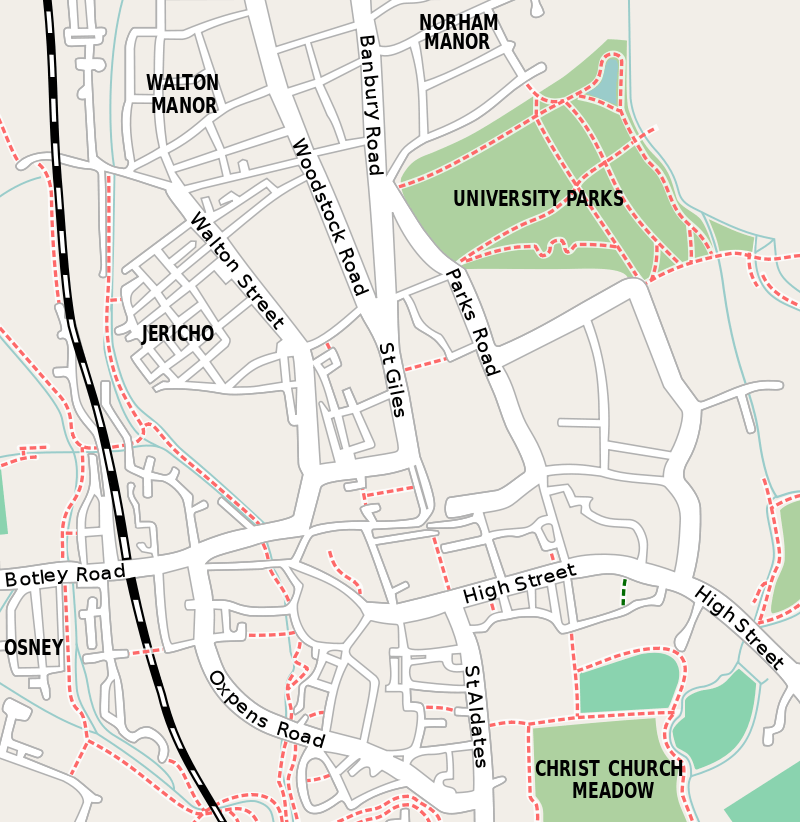Canterbury College, Oxford
Canterbury College, Oxford (1311–1540), was a University of Oxford college owned and run by Christ Church Priory, Canterbury. Shortly after the dissolution of the monasteries, the college's hall, chapel and other buildings were surrendered on 10 April 1540 and acquired by Christ Church.
| Canterbury College | |
|---|---|
| University of Oxford | |
| Coordinates | 51.7535°N 1.2500°W |
| Established | 1362 |
| Closed | 10 April 1540 |
| Named for | Owners – Christ Church Priory, Canterbury |
| Map | |
 Location in Oxford city centre | |
Background
The Priory first sent 4 monks to study in Oxford in 1311, in a hall it had bought there near the church of St. Peter-in-the-East, but the actual college was founded in 1362 by Simon Islip, archbishop of Canterbury, in the parish of St. Edward, opposite Oriel College.[1] It was to consist of twelve students (initially 4 monks and 8 "secular clerks" – i.e. ordained clergy who were not monks), under a warden, who would be a monk chosen by the Priory's prior and admitted by the archbishop. Its endowment was granted in 1363, and included the church of Pagham, Sussex, along with (initially) eight Oxford houses' rents and a portion of the rents from Woodford, Northamptonshire and Worminghall, Buckinghamshire, where the Priory had manors. Other endowments came in 1373, 1380, and 1392, eventually coming to about £86 a year, although these all gradually disappeared.
The licence to acquire land for building was only given in 1364 though 1365. Islip pulled out the monks and appointed as warden a secular clerk named, John Wycliffe. Then in 1366 Islip's successor as archbishop, Simon Langham, wished to put the monks back in place and litigation at the Roman Curia ensued. In 1368 Langham was appointed Cardinal and his influence induced the Curia to give judgment in favour of the monks in 1370.[2] One more monk was added in 1383, with the Priory paying for all 5 monks' maintenance at 10 pennies per week per monk. One of its students from Canterbury Priory was Thomas Chillenden, later Prior of the monastery. Rooms were rented to other Benedictine monasteries' members, including Rochester, Coventry, Battle, Peterborough, and Evesham, though all inmates were to a greater or lesser extent subject to Gloucester College's 'prior studentium'. Lay students were occasionally admitted to the college to make up numbers and provide some income. In 1426 the 'prior studentium' complained that Canterbury College's students were breaking Benedictine rules on eating meat.
Shortly after the dissolution of the monasteries by Henry VIII, the college's hall, chapel and other buildings were surrendered on 10 April 1540 and acquired by Christ Church.
In 2019, the Canterbury Institute was founded in Oxford, in memory of Canterbury College, by Dr Dominic Burbidge. The Institute focuses on rediscovering the academic vocation and hosts the Barry Scholarship.
Sources
Notes
- Eleanor Chance, Christina Colvin, Janet Cooper, C J Day, T G Hassall, Mary Jessup and Nesta Selwyn, 'Medieval Oxford', in A History of the County of Oxford: Volume 4, the City of Oxford, ed. Alan Crossley and C R Elrington (London, 1979), pp. 3-73. British History Online http://www.british-history.ac.uk/vch/oxon/vol4/pp3-73 [accessed 21 August 2018].
- Knowles, David. The Religious Orders in England, Volume II. Cambridge University Press, 1955, p. 21.